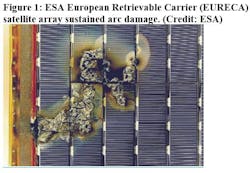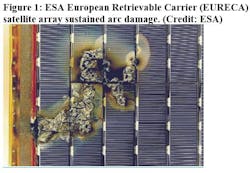Dissipative ETFE dielectric polymer helps control electrostatic discharge in wires and cables
By Chris Yun, principal engineer of aerospace, defense and marine, TE Connectivity
Recent tests by NASA’s Jet Propulsion Laboratory (JPL) and Goddard Space Flight Center show that new nano-carbon cross-linked ethylene tetrafluoroethylene (ETFE) helps controls electrostatic discharge (ESD) in wires and cables used on spacecraft.
Controlling static electricity in electrical interconnection systems is essential in spacecraft where ESD events can damage electronics and scuttle the mission.
In fact, it has been reported that 54 percent of spacecraft anomalies/failures are caused by electrostatic discharging and charging.[1] For example in April 2010, the Galaxy 15 telecommunications satellite wandered from its geosynchronous orbit. Reports in space technology literature suggested that spacecraft charging caused the anomaly. Fortunately, a workaround allowed the mission to continue. Worse off was the Advanced Earth Observing Satellite 2 (ADEOS-II), which lost power in October 2003. Forensic research identified that charging by high-energy auroral electrons was followed by a discharge event between power cables. The satellite was never recovered.[2]
An electrostatic charge can build up in any kind of wire and cable insulation. On Earth, a material can become electrically charged when electrically dissimilar materials rub together. But in wires and cables used in spacecraft, a static charge can be created by the impact of charged particles on the material. Space is filled with charged particles that can induce a charge in materials. Satellites in geosynchronous orbits and deep space missions are particularly susceptible because of higher charge density in GEO and deep space.
The use of high-resistivity dielectric materials and electrically separated surfaces in conjunction with the connected conducting surfaces of the spacecraft frame promote various forms of spacecraft charging.[3] When the charge builds up in wire and cable of electrical interconnection systems, a sudden discharge can damage connected logic circuits, electronic instruments, and computer chips (Figure 1).
Discharge voltage levels vary widely. To classify ESD events, several systems have been devised. The Human Body Model (HBM), which is the oldest system, is still used today as ANSI/ESDA/JEDEC Standard JS-001-2010 (Figure 2).
An inside look at static charge build-up
The primary factors that determine the speed and size of an electrostatic discharge are the material's ability to hold a charge (capacitance) and its ability to reduce the flow of electrons (resistance).
There are two ways to handle these factors in wire and cable. One solution employs metallic shielding to create a path that promotes electron flow, which dissipates the charge. The other strategy is to make the insulating materials dissipative, which suppresses the charge build-up.
Because of its high electrical and radiation resistance, ETFE is widely used as wire insulation and cable jackets in spacecraft electrical interconnection systems. ETFE also has a relatively high melting point, high strength-to-weight ratio, and high strength over a wide temperature range--also useful for spacecraft applications.
But ETFE has several electrical issues. It has high volumetric and surface electrical resistivity that allow electric charging in space environments. As a result, dissipative ETFE resins must be employed to promote static charge dissipation. Disordered carbon black molecules are used to make the material dissipative. By adjusting the volume% of carbon black in ETFE, volume resistivity of carbon-black-based ETFE is easily controlled within the range of 103 ~ 1016 Ohm-cm. Generally 107 ~ 1011 Ohm-cm is agreed to be dissipative.
But neither foil wrapping nor a carbon black/ETFE composition is suitable for all applications of wire and cable in spacecraft.
Metallic shielding adds weight and increases engineering cost. And in the case of carbon black/ETFE, the uneven distribution of carbon can allow a charge to build up in certain areas of the material. Raman spectroscopy reveals that carbon-rich and carbon-poor areas exist within carbon black/ETFE (Figure 3a). It is assumed that electrostatic charges build up inside the carbon-poor areas. Similar to a capacitor, the charge continues to build until the dielectric threshold is reached. Then an ESD event occurs--possibly discharging thousands of volts, which is why carbon black/ETFE has an ESD Class 2 rating (Figure 4).
Discovering how homogeneity improves resistivity
Using ETFE-insulated wire and cable that avoids weight but risks ESD is not particularly attractive to spacecraft designers. But today designers have an alternative ETFE thanks to a breakthrough in nano-carbon cross-linked ETFE fluoropolymers.
Unlike carbon black ETFE, nano-carbon ETFE provides an extremely low percolation threshold of about 0.5 vol%. This low threshold is due to high aspect ratio of nano-carbon. In fact, less than 1.0 vol% of nano-carbon provides sufficient conductivity to be dissipative, while it takes a vol% that is an order of magnitude higher to get the same for carbon black ETFE.
The problem of carbon agglomeration has been solved using a method developed by TE Connectivity Aerospace, Defense, and Marine. The process disperses nano-carbon throughout the polymer by suppressing the tendency of nano-carbons to agglomerate. The homogeneity of nano-carbon in cross-linked ETFE has been verified at the micron-level by Raman spectroscopic analysis (Figure 3b).
Furthermore, the ESD performance of nano-carbon cross-linked ETFE has been confirmed by NASA's Jet Propulsion Laboratory (JPL) in Pasadena, California, and Goddard Space Flight Center in Greenbelt, Maryland. During testing, an ETFE insulated wire was placed inside a chamber simulating a space environment with a -100ºC temperature and a 10-6 Torr vacuum. Then the material was subjected to a high-energy electron beam over a two- to eight-hour period. When the dielectric threshold was exceeded, a discharge finally occurred. Oscilloscopes were used to measure the voltage spike. With conventional carbon black/ETFE, the voltage reached 2000 volts and higher, rating Class 2 on the HBM scale. Nano-carbon cross-linked ETFE registered a discharge below 250 volts, a Class 1A rating.
In other words, the new ETFE material provides the same class of ESD control as foil-wrapped wire. Nano-carbon cross-linked ETFE satisfies the 1A ESD sensitivity classification defined in the Human Body Model of MIL-STD-883G and Method 3015-7.
It is also as easy to apply in space-grade wire insulation and cable jacketing as conventional cross-linked ETFE. With nano-carbon cross-linked ETFE, no metallic shielding is needed. That not only saves a substantial amount of weight, it also eliminates the expense of wrapping wire in foil, providing a cost-competitive solution that also shortens the time required by a jacketing process.
Use of new nano-carbon cross-linked ETFE helps address the concern that space radiation can generate a discharge that will travel through wire to short circuit electronics.
As an anti-static solution, space-grade wire and cable products made with nano-carbon cross-linked ETFE are now available as prototype samples.
TE Connectivity (TE) has been supplying electrical interconnection components to the Aerospace and Defense industry for over 50 years. In particular, TE has one of the industry’s broadest ranges of products suited specifically for the unique requirements of outer space. From our connectors, to our terminations, our harness accessories, and our wire and cable products, TE products are built to help withstand the vacuum outgassing, arc resistance, or resistance to atomic oxygen degradation encountered in outer space applications. These products also help meet the goal of optimizing the size and the weight budget for the mission.
[1] Koons, et al., Sixth Spacecraft Charging Technology Conference, Sept. 2000.
[2] "Understanding the Potential Dangers of Spacecraft Charging." Online article from the 2016 NESC Technical Update. (https://www.nasa.gov/offices/nesc/articles/understanding-the-potential-dangers-of-spacecraft-charging) Accessed 3/2/2017.
[3] Lai, Shu T., Fundamentals of Spacecraft Charging: Spacecraft Interactions with Space Plasmas (Princeton University Press, 2011), 1.
Search the Aerospace & Defense Buyer's Guide
The go-to resource for Intelligent Aerospace technology news & information:
Covering key topics
Across all market segments
Subscribe to the free Intelligent Inbox e-newsletter
Subscribe to receive all the latest aerospace technology news & information, delivered directly to your e-mail inbox twice a week (Tuesdays and Thursdays). Sign upfor your free subscription to the Intelligent Inbox e-newsletter at http://www.intelligent-aerospace.com/subscribe.html.
Connect on social media
Keep pace with aerospace innovation and opportunities via your favorite social media channels. Connect with Intelligent Aerospace on Twitter (@IntelligentAero), LinkedIn,Google+, and Instagram.





